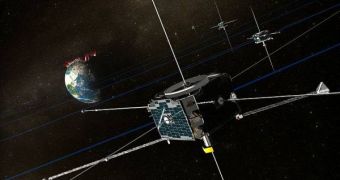Speaking on April 23rd at the general assembly of the European Geosciences Union in Vienna, Austria, University of California in Berkeley (UCB) Space Sciences Laboratory Space Physicist Andreas Keiling presented a few of the readings NASA's THEMIS satellite suite recorded when analyzing the formation of the light shows known as auroras. The probes, whose name is an acronym for Time History of Events and Macroscale Interactions during Substorms, were launched on February 17th, 2007, with the express purpose of studying energy releases in Earth's magnetosphere, and their influences on the planet and its atmosphere.
Space storms are cosmic events made up of massive swirls of plasma, which brutally interact with the magnetic field that protects our planet from harmful cosmic radiation. When space tornadoes occur during these storms, they cause giant funnels of hot and charged particles to start flowing towards the Earth at speeds of up to a million miles per hour (1.6 million kilometers per hour). The ions begin to circle the planet, but can only flow around the entangled magnetic lines that are generated by the planet's rotation, Space reports.
Because of these flow patterns, auroras at both the North and South Pole can be seen as being “curtain-shaped” at times. The vertical lines that appear in the curtains are actually the magnetic lines along which the particles flow. Their speed and electricity generates the exquisite light show for which the auroras have come to be known. The five identical satellites that make up the THEMIS system have revealed that the electrical currents produced by the tornadoes can be as strong as 100,000 amperes. The measurements were taken while the spacecraft traveled through the “lights,” roughly 40,000 miles above the Earth.
Despite their magnitude and strong currents, the tornadoes do not harm humans. However, electronic devices, communication networks and power transformers are easily incapacitated or burnt when subjected to the influences of the Northern and the Southern Lights. Experts are currently trying to use the satellite network to gain a better view of what happens inside these storms when they occur. In the future, the research could yield a better insight into how to protect the planet's power grids from being shut down during the peak of such storms.

 14 DAY TRIAL //
14 DAY TRIAL //